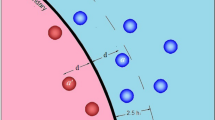Abstract
As the cavitating flow is multi-phase, gas and liquid phases coexist and show more complex nature than either single phase. Cavitation involves complex phase-change dynamics, and as a result, the inter-phase density is large. Due to the complex structure of the cavitation process, the computational fluid dynamics (CFD) modeling of cavitation is still a challenge. In this paper, a new approach based on a preconditioning technique to simulation of two-phase cavitating flows around a hemisphere-cylinder body has been developed. In the proposed method, pressure, velocity, and enthalpy were used as the original variables, energy equation was used instead of cavitation model which normally has no physical meaning, and Roe discrete format was adopted for the convection term. The pressure coefficient distribution and void fraction obtained in this study are in very good agreement with the previously published experimental and numerical results at different cavitation numbers. Therefore, the newly developed method shows great potential for simulating various types of cavitation.










Similar content being viewed by others
References
Ashley S (2001) Warp drive underwater. Scientific American, pp 42–51
Chen Y, Lu CJ (2006) Numerical investigation of ventilated cavitating flow around a 2D symmetry foil. J Hydrodyn (SerA) 21(1):62–68
Chen Y, Heister SD (1994) A numerical treatment for attached cavitation. J Fluids Eng 116(3):613–618
Deshpande M, Feng J, Merkle CL (1997) Numerical modeling of the thermodynamic effects of cavitation. J Fluids Eng 119(2):420–427
Iga Y, Yoshida Y (2011) Mechanism of propagation direction of rotating cavitations in a cascade. J Propul Power 27(3):675–683
Wang G, Ostoja-Starzewski M (2007) Large eddy simulation of a sheet/cloud cavitation on a NACA0015 hydrofoil. Appl Math Model 31(3):417–447
Iga Y, Hashizume K, Yoshida Y (2011) Numerical analysis of three types of cavitation surge in cascade. J Fluids Eng 133(7):071102
Ventikos Y, Tzabiras G (2000) A numerical method for the simulation of steady and unsteady cavitating flows. Comput Fluids 29(1):63–88
Edwards JR, Franklin RK, Liou MS (2000) Low-diffusion flux-splitting methods for real fluid flows with phase transitions. AIAA J 38(9):1624–1633
Gnanaskandan A, Mahesh K (2015) A numerical method to simulate turbulent cavitating flows. Int J Multiph Flow 70:22–34
Gnanaskandan A, Mahesh K (2016) Large eddy simulation of the transition from sheet to cloud cavitation over a wedge. Int J Multiph Flow 83:86–102
Du T, Wang Y, Huang C, Liao L (2017) A numerical model for cloud cavitation based on bubble cluster. Theor Appl Mech Lett 7(4):231–234
Liu D (2015) The numerical simulation of propeller sheet cavitation with a new cavitation model. Proc Eng 126:310–314
Turkel E (1999) Preconditioning techniques in computational fluid dynamics. Annu Rev Fluid Mech 31(1):385–416
Merkle CL, Sullivan JY, Buelow O, Venkateswaran PE (1998) S. Computation of flows with arbitrary equations of state. AIAA J 36(4):515–521
Huang DG (2007) Preconditioned dual-time procedures and its application to simulating the flow with cavitations. J Comput Phys 223(2):685–689
Huang D, Zhuang Y, Cai R (2007) A computational method for cavitation flows based on energy conservation. Proc Inst Mech Eng Part C J Mech Eng Sci 221(11): 1333–1338
Rouse H, Mcnown JS, Cavitation, Distribution P, Head forms at zero angle of yaw. Studies in Engineering, Bulletin 32, Iowa City, USA, Iowa Institute of Hydrolic Research State University of Iowa, 1948
d’Agostino L, Salvetti MV (2008) Fluid dynamics of cavitation and cavitating Turbopumps. Springer, Vien
Wang Y, Sun XJ, Dai YJ, Wu GQ, Huang DG (2015) Numerical investigation of drag reduction by heat-enhanced cavitation. Appl Therm Eng 75(22):193–202
Acknowledgements
This work was supported by National Natural Science Foundation of China (Grant No. 51536006).
Author information
Authors and Affiliations
Corresponding author
Additional information
Publisher’s Note
Springer Nature remains neutral with regard to jurisdictional claims in published maps and institutional affiliations.
About this article
Cite this article
Sun, X., Huang, D. Numerical analysis of cavitating flow around a hemisphere-cylinder body. J Mar Sci Technol 25, 138–147 (2020). https://doi.org/10.1007/s00773-019-00636-1
Received:
Accepted:
Published:
Issue Date:
DOI: https://doi.org/10.1007/s00773-019-00636-1




